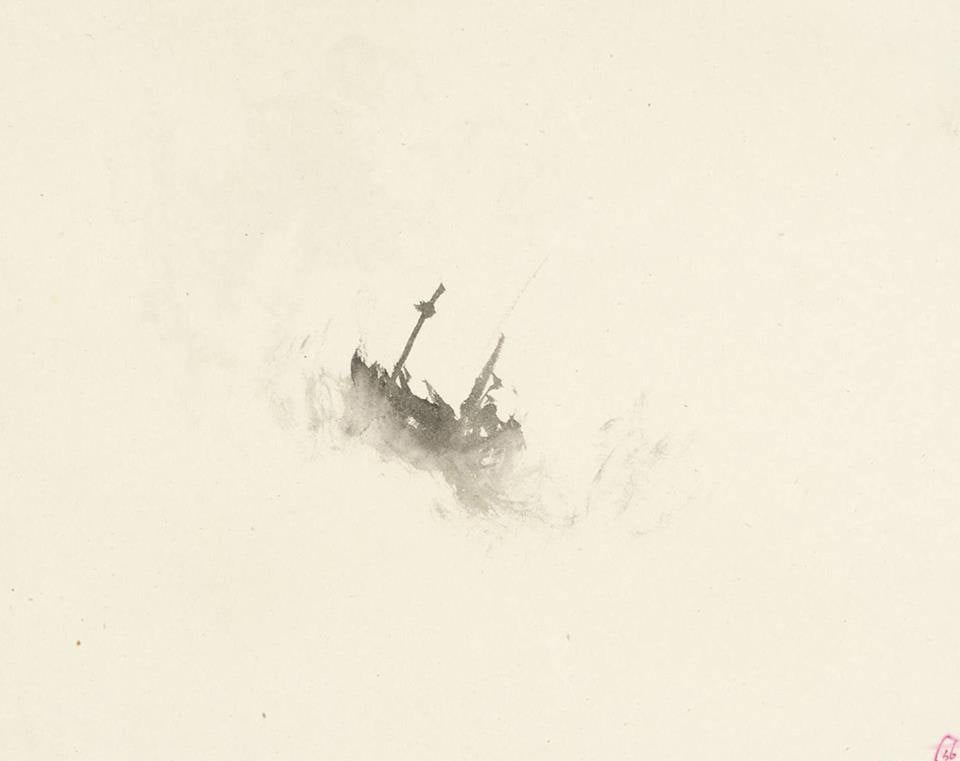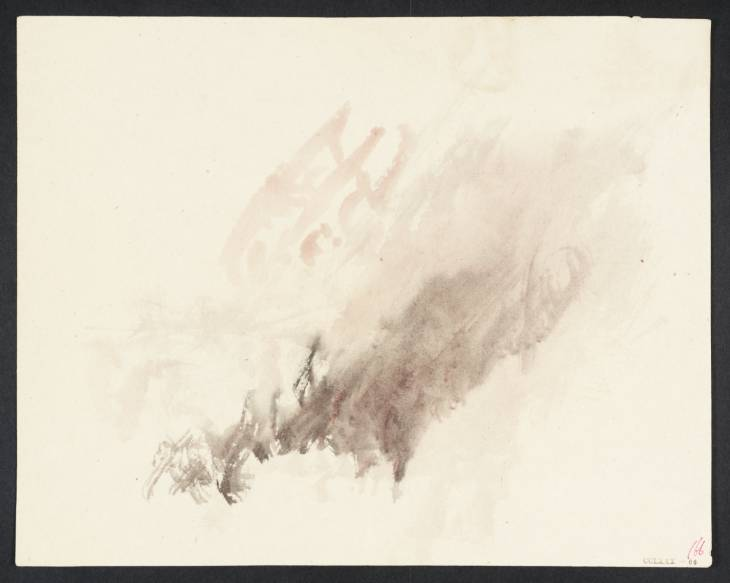Turner , Vignette: Study of a Ship in a Storm, c. 1826-36. Watercolour on paper, 18 x 22.7 cm.
J. M. W. Turner, 'Snow Storm-Steam Boat off a Harbour’s Mouth' 1842
J. M. W. Turner, studies for a ship in a storm
As artists we are never alone, all the artists we have ever looked at become fellow travellers on a journey to find the images that make sense to us in the time that we find ourselves to be in. Turner was an artist that had to face a growing awareness of a new age of industrial revolution, an age of steam and fire, one that would though eventually fuel climate change and global warming. He fuses weather with human endeavour, ships which when seen close to, are massive constructions, are rendered tiny and insignificant in the face of a boiling sea. He seems to sense the future changing of weather patterns, his images a sort of Tarot reading for the future, indications of our collective fate in the face of the wrath of the Earth's climate.
Covid feels as if it is but one aspect of the Earth's anger at our foolishness; now avian flu spreads out across the world, as sea levels rise and we all begin to worry about a coming winter of war and energy shortages and a lack of leadership when it comes to halting carbon emissions. My personal experience of these events was of Covid and during the summer I had a few moments of intense drama as a result of its attack on my respiratory system.
Respiration is like the weather, at most times your breathing is regular, rather like the soft breezes that are nearly always stirring a few leaves or animating some blades of grass. But every now and again there is a dramatic event, such as when breathing is no longer automatic. In this case I couldn't get air into my lungs, covid had somehow found my weak spot, asthma, which for a while had been controlled and almost as far as I was concerned gone; it flared up and I was caught out, outside without an inhaler. First of all coughing uncontrollably and then finding I could no longer get any air into my lungs. I nearly collapsed, but as soon as I was able to I tried to visualise what it felt like. The internal 'storm' I had experienced was like the weather, something that had blown through me, but something that was also blocked, as if it was trying to blow down a narrow valley, but there had been a landslide and the route was blocked.
The world is for the most part shackled by attraction, grasping, and insisting.
But if—when it comes to this attraction, grasping, mental fixation, insistence, and underlying tendency—you don’t get attracted, grasp, and commit to the notion ‘my self’, you’ll have no doubt or uncertainty that what arises is just suffering arising, and what ceases is just suffering ceasing. Your knowledge about this is independent of others.
This is how right view is defined.
‘All exists’: this is one extreme.
‘All doesn’t exist’: this is the second extreme.
Avoiding these two extremes, the Realised One teaches by the middle way:
From Kaccānagottasutta: Bhikkhu Sujato: Linked discourses on causation
References
Edgar, D: (2019) Agitating the void. Tracy special issue: Drawing Phenomenology: tracing lived experience through drawing Volume 14 Issue 1 ojs.lboro.ac.uk/TRACEY
Morton, T. (2013) Hyperobjects: Philosophy and Ecology after the End of the World. New York: U of Minnesota Press.
Seth, A., (2021) Being you: A new science of consciousness. London: Penguin.
Sutta Central: Early Buddhist Texts Available from here
Choong, M.K., (2000) The Fundamental Teachings of Early Buddhism: A comparative study based on the Sutranga portion of the Pali Samyutta-Nikaya and the Chinese Samyuktagama (Vol. 32). Otto Harrassowitz Verlag.
Shìh, H. (2013) Dependent Origination= Emptiness”–Nāgārjuna’s Innovation? An Examination of the Early and Mainstream Sectarian Textual Sources. Journal of the Centre for Buddhist Studies, Sri Lanka, 11, pp.175-228.
See also:
The etymological root of art
Above: Studies for the internal awareness of breathing problems, the final image was an attempt to visualise the moment when air broke through into the blocked airways.
The studies above were made using watercolour and ink based liquid solutions, with added granular bits that were a product of drying out solutions and grinding the results into powder and adding this to the various inks and watercolour solutions I was using. As well as hand manipulated and materials led image making, some images were then further manipulated in PhotoShop to heighten colour saturation or to add a layer of graphic forms designed to indicate where constriction was occurring, in a similar way to how a doctor would draw on an x-ray to show where a bone was broken or where a tumour was present.
Frank Auerbach's drawings above, feel as if it is still windy, they respond to trees and bits of paper being blown around, sketched while he himself was being wind blown.These images, as well as my own and Turner's appear as if they are dissolving back into the world they come from, they are not fixed, they are events. For myself this is an important process, as it echoes what is going to happen and has happened and is happening constantly and forever throughout the eternity of the universe's existence. The flow of elements and their constant metamorphosis is very like the weather, shapes blown into being for an instance and then dissipating as the wind changes direction. My moment of breathlessness a tiny insignificant event within the ever interlinking events of nowness. My problem breathing reminded me of the void, as I tried to take in air, suddenly I found non, instead there was a vacuum and the vacuum was an emptiness into which not then perhaps, but one day I will have to empty myself into. The images I have been making are very like thousands of other images artists have made, far too many to identify individually, but all perhaps made in recognition of the cosmic flow of everything. This reminds me again of one of the etymological roots of our word 'art'; the phoneme 'rt', the ancient indo/european sound of the dynamic process by which the cosmos continues to be created.
Kano Motonobu - Ink Landscapes
The landscapes by Kano Motonobu above are from the early 16th century. They are hardly there, images of mist and light, ink dissolving into water as reality fades. They were prized in their time as reminders of the insubstantial nature of existence, of the fact that we dance lightly over the Earth and that we need to treasure the fragility of our lives. These images, like Turner's have been faithful fellow travellers for myself, reminders that art is a collective activity, that it is not about originality but about being able to pick up the baton that is passed to you by the many that have gone before and being true to the flow of time and the materials that you interact with. Perhaps the Buddhist world understands these things better than most, as it is said, 'this world mostly relies on the dual notions of existence and non-existence,' these are however extremes and we negotiate our way between them.
The world is for the most part shackled by attraction, grasping, and insisting.
But if—when it comes to this attraction, grasping, mental fixation, insistence, and underlying tendency—you don’t get attracted, grasp, and commit to the notion ‘my self’, you’ll have no doubt or uncertainty that what arises is just suffering arising, and what ceases is just suffering ceasing. Your knowledge about this is independent of others.
This is how right view is defined.
‘All exists’: this is one extreme.
‘All doesn’t exist’: this is the second extreme.
Avoiding these two extremes, the Realised One teaches by the middle way:
From Kaccānagottasutta: Bhikkhu Sujato: Linked discourses on causation
References
Edgar, D: (2019) Agitating the void. Tracy special issue: Drawing Phenomenology: tracing lived experience through drawing Volume 14 Issue 1 ojs.lboro.ac.uk/TRACEY
Morton, T. (2013) Hyperobjects: Philosophy and Ecology after the End of the World. New York: U of Minnesota Press.
Seth, A., (2021) Being you: A new science of consciousness. London: Penguin.
Sutta Central: Early Buddhist Texts Available from here
Choong, M.K., (2000) The Fundamental Teachings of Early Buddhism: A comparative study based on the Sutranga portion of the Pali Samyutta-Nikaya and the Chinese Samyuktagama (Vol. 32). Otto Harrassowitz Verlag.
Shìh, H. (2013) Dependent Origination= Emptiness”–Nāgārjuna’s Innovation? An Examination of the Early and Mainstream Sectarian Textual Sources. Journal of the Centre for Buddhist Studies, Sri Lanka, 11, pp.175-228.
See also:
The etymological root of art
Alina Popa: Disease as an Aesthetic Project
David Edgar's presentation on the void
Absence, emptiness and the void
Non western aesthetics
















No comments:
Post a Comment